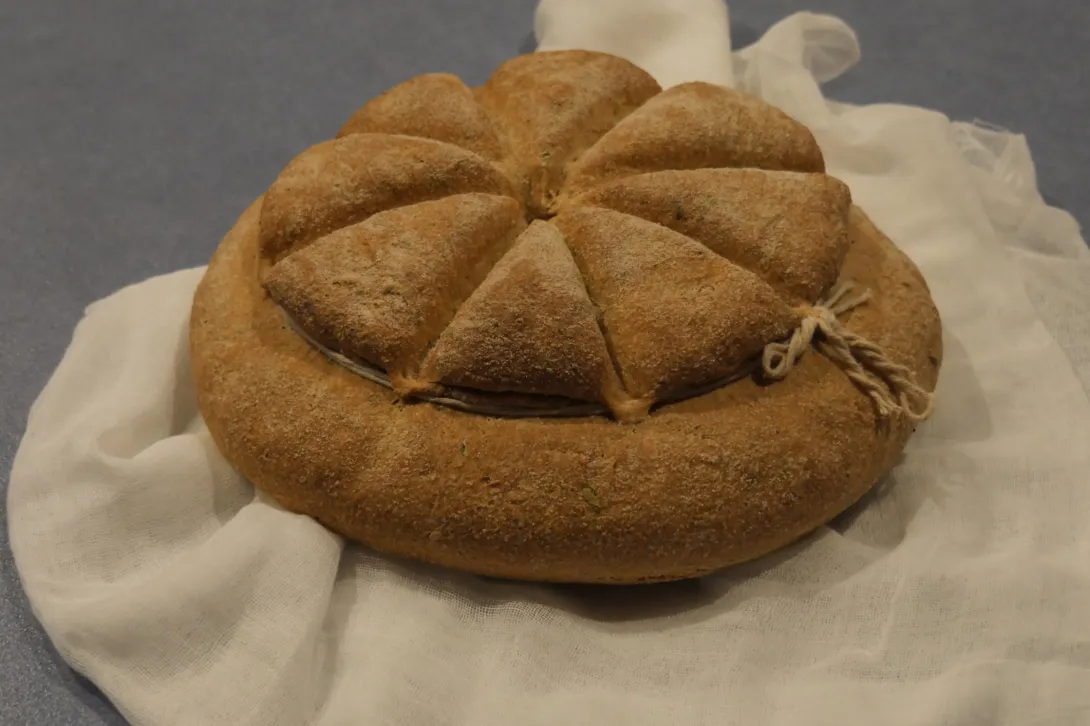
I recently discovered a blog called: Tavola Mediterranea - Home of Culinary Archaeology on the Web. It is a fascinating and very informative blog on ancient history and baking. Two breads on this site really caught my attention and had me heading into the kitchen. The Roman Panis Quadratus and a Greek Prosphora.
The first bread I baked is Panis Quadratus. It featured in a post on baking with the Romans. The most interesting thing about this bread is that carbonised loaves were unearthed from the ruins at Pompeii. This version is a 100% wholewheat sourdough loaf that contains poppy seed, fennel seed and parsley. I think my modern wholewheat was not quite strong enough or else, I must not have tied the belt around the toga tight enough. My bread developed a bit of a belly, like a lazy Roman emperor. It is a reasonably dense loaf, but not heavy and tastes really good.
I will try her second version that is 50% wholewheat and 50% spelt flour next.


A carbonised bread from the Pompeii ruins.
- Anne-Marie B's Blog
- Log in or register to post comments
Anne, your bread is beautiful! I get the string wrapped around the circumference. How did you get the “slices” on the top? Did the first attempt at this bread turnout well for you?
Thanks for sharing.
Danny
This was actually my first attempt at this loaf. That is why I got the 'belly'. I hope that the next attempt looks more authentic. I think I could definitely have tied the string a bit lower down too. That might have resulted in a more even division of the loaf. The slices on top of the bread is made with a wooden dowel. I pressed as far as the string to get the divisions to stay during baking. I used a 5mm diameter dowel. Then I used the handle of a wooden spoon to press a hole in the centre, right down to the bottom of the bread to help steam escape as suggested in the recipe in her blog - Baking with the Romans Parts I-III. I am having good fun baking with the ancient Romans and Greeks. I hope you do too.
Anne-Marie
I understand now.
Is there any special treatment for the binding string?
Does it come off the bread easily?
No special treatment at all. The bread was dusted with semolina before I did the mods. The string came off very easily after cooling down.
Ps: The string and dowel happened after the 2nd rise and just before going into the oven.
I’m working on a Panis quadratus loaf right now-my first. I’ve mixed the dough and will let it retard overnight so I won’t be shaping it until tomorrow, and hope you can help allay my worries. In her article on Tavola Meterranea, Farrel Monaco says to press the dowel into the loaf, but not how deeply. Breadtopia’s recipe, based on her’s, says to “press down almost to the countertop.” That worries me; I’m a bit afraid that much pressure will collapse the risen dough. Certainly if that happens it can be reshaped and allowed to rise again, but I’d rather not have to do that! Having handled her recipe, do you think the loaf will stand indenting almost to the countertop or is that overly optimistic?
I found cicerchia ‘beans’ at Rancho Gordo and will start Pliny’s chickling vetch/barley starter tomorrow. Fingers crossed!
https://www.ranchogordo.com/products/cicerchia-bean
Hi Ju-Ju, apologies for the slow answer. We had a terrible storm last week which knocked out our power until Sunday night. As far as I remember, I dusted my dowel and very gently turning it round and round, worked it into the dough. Not all the way to the countertop, but quite deep enough so that it would not close up during baking. My dough was reasonably firm, which is why I could tie the string around it too.
Good luck with your loaf and your starter. I live way too far from a city to really find unusual ingredients like Cicierchia beans here.
Two shaped loaves one on top of another as seen in this ancient mosaic. After stacking, dowel mark the top loaf.
http://www.thefreshloaf.com/node/34742/overdone-toast
Perhaps I should have stacked instead of tying a string. Then I would not have had that belly on my bread. I will keep at it until perfect :) Thank you.